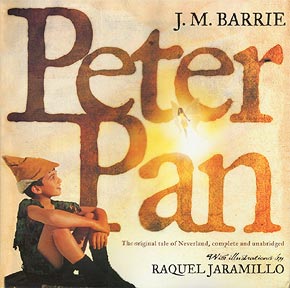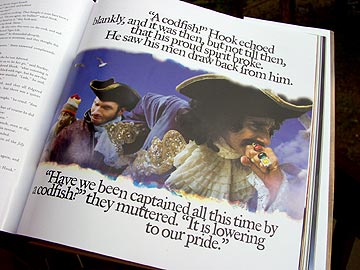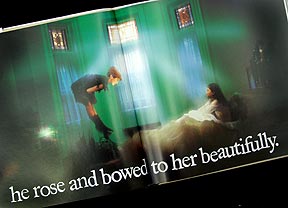
Caprice Garvin: What exactly is photo illustration?
Raquel Jaramillo: I’m sure there’s probably a more technical definition out there than the one I’m going to give, but I would say photo illustration is art that, to whatever degree, uses photography as a means to an end rather than simply the end result.Photography as an art form is very different because it is not manipulated at all: the photograph comes from the negative, and the art is in the capturing of a very real moment in time. Photo illustration, as I see it, uses photographs in a very different way.I use the photos I take as a launching pad, a small part of a very big picture. My approach is much more like a painter’s approach: I compose the image, decide what type of lighting to use on the subjects, photograph the different characters–sometimes not together–photograph the backdrop, the props, and then compose them using a computer program called Photoshop so that the final product has the semblance of a real photograph, although it is, in theory, more like a painting. I actually think of the work I do as a kind of “dream photography” because its goal is to create imagery that looks like photographs taken inside someone’s dreams: not quite real, not quite unreal.
CG: How did you first become interested in photo illustration?
RJ: I’ve spent the last 15 years working as a book jacket designer and art director, so illustration is something I’ve always done professionally, to some degree or another. Back when I first graduated from Parsons School of Design I still used paints and brushes, of course. I first started using Photoshop in 1991, and became pretty adept at it, growing with the product as it itself grew.I always tended to veer away from some of its more computery special-effects filters, though, because they always seemed like the equivalent of paint-by-numbers for non-artists to me. I started incorporating my own photography into my illustration using Photoshop in the mid-90s, and then in 1997 I started working on my baby board books, Ride, Baby, Ride and Dream, Baby, Dream, published by Little Simon. These two board books used photos of babies doing extraordinary things: babies flying on magic carpets, riding on tigers. In these, my goal was to use the computer to try and make the situations look real, but the images were meant to be part of this world, not some make-believe world. With Peter Pan, my next project, the goal was to use both Photoshop AND the photos to create an alternative world: Neverland. That was the beginning of “dream photography” as a kind of philosophical goal for me, the point where it stopped being about the technical aspects of “how” the image is created to being about the art of “what” image is created.
CG: Are their many artists who practice the art of photo illustration? In the United States? In the world?
RJ: I know there are a lot, there’s a whole community out there: but I really don’t know anyone.

CG: What artists have most greatly inspired you in your own work?
RJ: Maxfield Parrish. The Pre-Raphaelites. Movies by Merchant/Ivory, Franco Zeffirelli.
CG: Your latest work is a photo illustrated version of the original tale of Neverland. I understand that until now, PETER PAN had never been illustrated photographically. What inspired you to interpret PETER PAN through photographic imagery?
RJ: My son, Caleb, fell in love with the Disney movie of Peter Pan when he was two years old. It reminded me of the fact that I had loved Peter Pan when I was a kid, too: something I actually had forgotten all about. I started reading the original James Barrie novel and was completely floored: what a beautiful book!I guess, like so many other people, I had assumed that I had read it already. It’s a story that’s so familiar, so part of our pop culture, you can’t help but assume you’ve read it before, but I bet you most people haven’t. And as I was reading it I just started seeing images in my head, like a film, and I thought:I could do this. I wanted to make it seem real, to flesh out the characters, give them the kind of humanity that Barrie had given them which the Disney film, by virtue of its being a cartoon, just couldn’t give them. That’s not to disparage the cartoon at all, by the way, because I LOVE that movie, but in the end these characters are not cartoons, not the way Barrie portrayed them.There’s a tenderness in the story of Peter Pan that I wanted to convey: the love between Peter and Wendy, Mrs. Darling and her children. And there’s a very scary element, too: Captain Hook.Far from being the fop he was in the cartoon, this guy was really one twisted, tortured soul.
CG: What was your greatest challenge in creating PETER PAN?
RJ: Casting was essential, finding the right people to portray the characters as I saw them. Getting the costumes, props, backdrops, etc., and trying to coordinate all the multitude of characters was tricky. Also, designing the book so that the captions flow into the text while simultaneously serving as captions to the illustrations. This was really hard but essential, because I wanted this book to be readable by adults and older kids AS WELL as by younger kids like my son. The beauty of the book, I think, is that parents can read a simplified version of the story to their kids by just reading the captions to the illustrations.
CG: When you look through PETER PAN, is there a particular picture that stands out as a favorite?
RJ: I have two. One favorite is a picture early on in the book, the one in which Peter is in the air, bowing to Wendy, under which the captions reads: “he rose and bowed to her beautifully.” This was the very first image I did for Peter Pan, the one in which, as I worked on it, made me realize I had the makings of something special. The text never says he rises in the air, but I thought: if Peter can fly, his bow would of course take him off the ground. It added the element of magic to the text which is exactly what I hoped to give the whole book. My other favorite, for far more sentimental reasons, is the picture of the lost boys: my son, who inspired this whole book, plays the twin lost boys, and I love the way that picture makes all those boys look so hauntingly beautiful and vulnerable at the same time.

CG: Any idea what your next project will be?
RJ: The Night Before Christmas is scheduled to be published by Athenuem Books for Young Readers this Christmas. It’s not a big coffee table book like Peter Pan, and the photos are, unlike the dream photography of Peter Pan, meant to look like real photos of a real place, taken a long time ago.They’re all in sepiatone: of Santa and the reindeers.
by Caprice Garvin

Leave a Reply